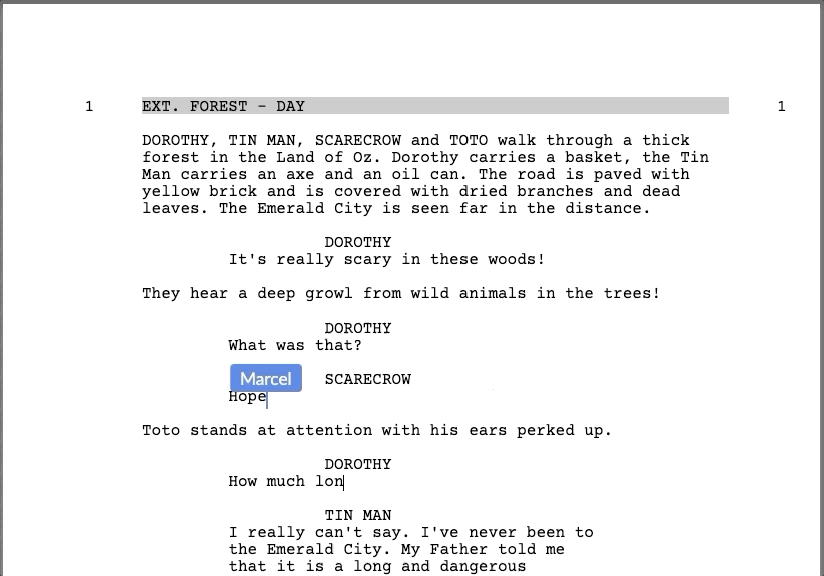
Everyone has a story to tell. Whether it’s a hilarious mishap, a moment of personal triumph, or a sprawling epic, storytelling connects us. It’s how we share ideas, spark emotions, and bring people into worlds they’ve never seen.
But what makes a story good? Compelling characters? A clear throughline? That perfectly timed twist that keeps readers hooked?
In this blog, Neil Chase shares 11 actionable tips to help you craft your story, no matter your medium. From raising stakes to writing natural dialogue, these essentials will guide you through the creative process, one step at a time.
Ready to get started? Let’s dive in.
In this Article:
- Write Interesting, Believable Characters
- Include Various Types of Conflict
- Keep a Consistent Throughline
- Use a Script Writing Software
- Raise the Stakes for Your Characters
- Include a Memorable Ending
- Use Dialogue Effectively
- Use Strong Descriptions (“Show, Don’t Tell”)
- A Good Story Needs Tension and Suspense
- A Good Story Needs Well-Timed Pacing
- Edit, Edit, Edit!
- Online Storytelling Resources
- FAQ: Storytelling
- Conclusion

This article teaches you how to write a good story, no matter your skill level.
Whether you want to write a novel, a screenplay, or just a good old-fashioned short story, there are some universal elements that all good stories need.
Let’s get started with 11 tips to help you write a good story:
1. Write Interesting, Believable Characters
Good stories require relatable characters that readers will remember long after they finish the book. There are a few key things to keep in mind when creating characters that will make your story stand out.
- First, give your main character a memorable introduction, and in doing so you’ll ensure a good beginning for your story as well. Remember that one’s actions say more about them than their words, so always try to show, rather than tell. An active character who shows their qualities – good or bad – from the outset is far more memorable and dynamic than one who just stands there and talks.
- Second, give your main characters unique qualities and flaws that will make them complex and interesting characters. No one wants to read about a perfect person – we all have our quirks and vulnerabilities, and your characters should too.
- Third, ensure your character(s) undergo some kind of development or change throughout the story. We grow and learn from our experiences, and your characters should also.
- Fourth, be consistent with your characterizations – if you establish early on that your protagonist is shy and introverted, don’t have them boldly approaching strangers in later scenes.
These tips will ensure that you create memorable characters with flaws and dimensions, not just one-dimensional caricatures. Your readers should be able to relate to your character’s life and feel invested in their journey.
Before you start writing your screenplay or novel, make sure to use screenwriting software or novel-writing software programs to ensure that your work adheres to industry standards in terms of format and appearance.

2. Include Various Types of Conflict
All interesting stories need conflict. Without it, there is no drama, tension, or sense of forward momentum. Conflict drives change, and change drives story.
The conflict can be internal, such as a character struggling with a difficult decision, or external, such as a character facing an obstacle. Remember, external conflicts are easier to tackle than inner struggles, as they typically don’t require any inner change on the part of the character.
True change comes from within.
What is important is that the conflict feels real and believable, and that it has a meaningful impact on both the character and the story. So make sure that you create obstacles for your characters to overcome so that they have to struggle and grow in order to succeed.
3. Keep a Consistent Throughline
One of the most important aspects of writing a good story is making sure that there is a throughline – the central question or problem that your story is trying to answer. From the opening lines in the beginning to the closing image at the end, you must keep it in mind.
Without a throughline, your story will likely wander and lose focus, leaving readers confused and uninterested.
There are a few ways to ensure your throughline is clear and compelling.
- First, ensure the throughline is introduced early in the story. This will help to ensure that readers are aware of the central conflict from the beginning and will be more invested in seeing how it plays out.
- Additionally, be sure to maintain focus on the throughline throughout the course of the story. Every scene and every event should relate back to the throughline in some way, helping to move the story forward and keep readers engaged.
When thinking about the central problem in your story, consider:
- Who is the main character of your story?
- What does this character want?
- What are they trying to achieve?
- What obstacles will they have to overcome?
- What inner flaws hold them back?
Your story should be focused on your character’s journey to reach their goal.
4. Use a Script Writing Software
Using a scriptwriting software like Celtx can be a helpful way for screenwriters to improve their screenwriting skills. Scriptwriting software provides a standardized format for writing scripts which makes it easier for industry professionals to read and understand a writer’s work.

Additionally, most scriptwriting software has built-in script breakdown features, which can help writers analyze and understand the structure of their script. These types of features can help writers identify areas where their script may be weak and make necessary changes to improve it.
Scriptwriting software like Celtx also allows users to export their scripts in various industry-standard formats, such as PDFs, making it easier for writers to share their work with others.
5. Raise the Stakes for Your Characters
When you write stories, one of the key elements is to keep upping the stakes for your characters.
This means that as the story progresses during the rising action, the challenges and obstacles your characters face should become more and more difficult. This will hook readers, as they’ll want to see how your characters will manage to overcome these increasingly complex challenges.
There are a few ways you can do this.
- One is to have the stakes increase in terms of the personal costs for your characters – for instance, if they’re originally trying to achieve something that would benefit themselves, you could raise the stakes so that failing to achieve their goal would also have negative consequences for other characters.
- Another way to up the stakes is to increase the physical dangers or threats your characters face. This could be anything from adding more dangerous opponents to raising the stakes so that failure would mean death or severe injury.
And remember that the point of highest stakes and excitement needs to be at the climax of the story when the central conflict is settled once and for all. Everything the character has gone through and all the lessons learned since the inciting incident must apply in this final moment. A truly effective climax is one where the character and audience both genuinely don’t know if the protagonist will succeed. That can only be achieved with rising stakes and difficulty.
As you raise the stakes for your main character, think about:
- What happens if your character fails?
- What is at stake if they succeed?
- What is the character willing to trade or give up to reach their goal?
- The higher the stakes, the more suspenseful and exciting your story will be!
Whatever approach you take, remember that giving your main characters many obstacles during the rising action is essential for writing a good story.
6. Include a Memorable Ending
Creating a memorable ending is one of the most important aspects of the story-writing process. A good beginning is important, but the ending should also be definitive and satisfying, providing a sense of closure for the reader.
To achieve this, the ending must be well-planned and executed with precision.
First, identify the story’s climax – this is the point at which the conflict is resolved, and the tension is released. The central throughline is addressed here, and good or bad, the central conflict comes to an end.

Then, start winding down the story, tying up loose ends and wrapping up plot threads. The pacing should slow down at this point as the story builds toward its resolution. This is commonly referred to as the falling action section of your story.
Falling action ties up all loose ends and plot holes and shows us how the hero’s world has changed, for better or worse, as a result of their undertaking the challenge in the first place.
This allows you to write an ending that feels earned and satisfying. The ending should be emotive and resonate with your audience. Whether it is happy or sad, it should evoke a strong reaction in the reader.
This is what people will remember long after they’ve finished reading or watching your story, so make it count! Don’t cop out with a cheap or predictable ending; make it earned and satisfying. If done well, a good ending will leave the reader with a lasting impression of your story.
Stumped on how to wrap things up? Try this article from Celtx: How to End A Screenplay
7. Use Dialogue Effectively
Good dialogue is an essential element of any good story. It can convey a character’s personality, advance the plot, and provide information to the reader. Here are some tips to help you write dialogue that will keep your readers engaged:
- Make sure your dialogue sounds natural. Avoid stilted or overly formal speech. Your characters should sound like real people talking to each other.
- Use dialect and colloquialisms sparingly. While they can add color to your dialogue, too much can be difficult for readers to follow.
- Keep your dialogue brief. Long blocks of uninterrupted speech can be tedious to read. Instead, break up your dialogue with action or description, and save the speeches for when they matter the most.
- Be aware of pacing. The rhythm of your dialogue should match the pace of your story. If your story is fast-paced, your dialogue should be as well.
- Avoid exposition dumps and on-the-nose speeches; let your dialogue move the plot forward while also revealing character personality traits. The best dialogue is loaded with subtext.
By following these tips, you can ensure that your dialogue will be a powerful tool that will help you tell a great story.
8. Use Strong Descriptions (“Show, Don’t Tell”)
Anyone who has taken a creative writing class has likely heard the advice, “show, don’t tell.” This means that good description is key to writing a good story.
A good writer makes the readers care about their characters through their actions, which are as important, if not more so, than a character’s thoughts and words. Readers want to be able to visualize the characters and setting, and this can only be done with well-written descriptions.
This does not mean that every detail needs to be spelled out; in fact, too much description can be just as bad as too little. The goal is to provide just enough information to allow the reader to create a mental image without overwhelming them with unnecessary details.
The description sets the scene and allows the reader to visualize what’s happening in their minds. Be specific and evocative with your language so that the reader feels like they’re right there in the thick of things alongside your characters.
Rather than just telling the reader what’s happening, show them through action and dialogue. This will help them feel like they’re experiencing the story firsthand rather than just being told about it secondhand.
The best way to achieve this balance is to focus on the senses. What does the character see, smell, hear, taste, and feel? Done well, readers feel and experience the world along with the characters.
By painting a vivid picture using all five senses – in addition to what characters think, remember, fear, and dream of – writers can create unforgettable stories that will stay with readers long after they’ve finished the last page.
9. A Good Story Needs Tension and Suspense
A good story needs tension and suspense in order to keep the reader engaged.
One way to create tension is by introducing conflict early on in the story. This can be done by having the protagonist face off against an antagonist or by having them come up against a challenging situation. It is also effective for character development, as early conflict gives us insight into the character’s flaws and how they need to change for the better in order to succeed later.
Another way to create tension is by building up to the climax, which should be a pivotal moment in the story that changes the course of events. This can be done by withholding information, gradually revealing information about the characters or the plot, or by raising the stakes throughout the course of the story.
Remember, tension and suspense are not about revealing information but withholding it until the last possible moment.
” There is no terror in the bang, only in the anticipation of it.“
Alfred Hitchcock
By creating tension and suspense, writers can keep their readers hooked from beginning to end.
10. A Good Story Needs Well-Timed Pacing
Pacing is how fast or slow your action unfolds.
A well-paced story will have moments of high action balanced with slower moments of reflection or character development. If everything happens too quickly, readers may get overwhelmed or lose interest; if things are happening too slowly, they may get bored. Finding the right balance of action and reflection will keep readers invested in both the memorable characters and plot.
As noted in this article from the Nevada Film Office, there are a few key elements that can help to ensure great pacing in a story.
- The plot should be carefully structured so that each scene leads logically to the next, even when taking into account surprises and unexpected developments.
- The pacing should be varied throughout the story, with some faster-paced sections to break up the monotony and some slower-paced sections to allow for moments of reflection.
- The dialogue should be sharp and snappy, without any unnecessary pauses or meandering conversations.
- Your story should always be moving forward; there should never be a scene or chapter that feels like it could be cut without affecting the rest of the story. Every element of your story should serve a purpose and advance the plot in some way.
Related Celtx Reading: How to Write a Good Story Using the 5-Act Structure
11. Edit, Edit, Edit!
Once you’ve finished writing, put your work away for at least 24 hours; as this will give you some much-needed distance from your work so that you can come back to it with fresh eyes. Then, go through your work with a fine-tooth comb and get rid of anything that isn’t absolutely essential. A good story is one that has been thoroughly edited; don’t try to publish something before it’s ready.
After you’ve done your best to edit your work, the best way to further improve your story is to get someone else to read it and give you their constructive feedback. Doesn’t matter if they’re a family member, friend, or professional editor – just so long as they’re willing to be critical and you are open to addressing shortcomings. You need to know what’s wrong with your story so you can fix it.
Remember, the editing process needs to address technical aspects, such as formatting, spelling, grammar, and so on, as well as aspects of the story itself, such as plot, characters, dialogue, pacing, and theme. Using film production software programs (such as Celtx) can help you keep track of these aspects of filmmaking.
Once you’ve made the necessary changes, it’s time to get feedback again. Repeat this process until you’re sure your story is the best it can be. Only then should you think about submitting it to producers, executive producers, agents, screenplay competitions, or posting it to script-sharing sites. Remember, the competition is fierce, so make sure your story is the best it can be before you send it out into the world.

Side Note: There’s No Shame in Using Online Resources
Whether you’re just starting out or are looking to improve your craft, these resources can provide valuable insights, tips, and tools to help you become a better writer. Here’s a curated list of helpful platforms and websites to guide your writing journey:
- The Writer’s Digest
- What it offers: A treasure trove of articles, workshops, and tutorials covering various aspects of writing—from character development to mastering plot structure. Writer’s Digest also has a vibrant community of writers for support and feedback.
- Why it’s useful: Whether you’re looking for writing prompts or need expert advice on publishing, Writer’s Digest is a one-stop shop for both novice and seasoned writers.
- Reedsy Learning
- What it offers: Free online courses taught by industry professionals, covering everything from writing techniques to marketing your work.
- Why it’s useful: Reedsy’s courses are designed for writers of all levels and are led by authors, editors, and literary agents who know what it takes to make a successful story.
- National Novel Writing Month (NaNoWriMo)
- What it offers: A month-long writing challenge every November that encourages writers to complete a 50,000-word novel in 30 days. The site also provides writing tips, goal-setting tools, and a supportive writing community.
- Why it’s useful: NaNoWriMo is perfect for setting ambitious goals and meeting deadlines. The community is full of motivation, advice, and accountability, making it a great resource for anyone struggling to stay on track.
- Writing Forward
- What it offers: A blog filled with writing prompts, grammar tips, exercises, and advice on improving your writing style.
- Why it’s useful: The site is packed with actionable advice that will help you develop a strong voice and refine your storytelling skills. Writing Forward is ideal for those looking for quick tips and exercises to stay sharp.
- Celtx
- What it offers: Celtx provides comprehensive software for scriptwriters, with tools for outlining, organizing, and formatting scripts to industry standards. The platform also offers resources on storytelling, including articles and webinars.
- Why it’s useful: With Celtx, writers can streamline their process and ensure that their scripts meet professional standards, whether they’re screenwriters or working in other narrative forms.
- Storytelling for Impact by Stanford’s d.school
- What it offers: This online resource focuses on storytelling from the perspective of design thinking, helping writers craft stories that connect with audiences emotionally and practically.
- Why it’s useful: The storytelling techniques and strategies offered in this course can be applied to both creative and business storytelling, making it versatile for writers in various fields.
- ProWritingAid
- What it offers: A writing tool that checks grammar, style, readability, and even offers suggestions on how to strengthen your writing. It’s like having an editor at your fingertips.
- Why it’s useful: ProWritingAid helps writers polish their drafts, improve sentence structure, and refine their writing style, all while catching potential errors that may have slipped through the cracks.
- Script Lab
- What it offers: A site dedicated to screenwriting, with articles, video resources, script breakdowns, and analysis of successful films to help writers better understand structure and character development in film.
- Why it’s useful: If you’re working on a screenplay, Script Lab is a great resource for exploring the intricacies of the craft. It also offers free screenplay downloads and analysis to help you study the greats.
Frequently Asked Questions: Storytelling
What are the Steps to Write a Good Story?
There is no single formula for writing a good story, but there are a few important elements that should always be considered. First, it is important to choose an engaging subject matter that will captivate the reader’s attention. Next, the story should have a strong narrative arc that builds tension and keeps the reader interested. Finally, the story should be populated with well-developed characters who feel real and relatable.
Focus on your story, not formatting. Click here to try Celtx today.
What are the 7 Elements of a Story?
A story has seven elements: characters, plot, setting, conflict, resolution, theme, and point of view. Characters refer to the people (or animals) who populate the story, and their character development. Plot is the sequence of events that take place. Setting is the time and place of the story. Conflict is the problem that needs to be resolved. Resolution is the solution to the conflict. Theme is the underlying message of the story. Point of view is the perspective from which the story is told. All seven elements are essential to a successful story.
What are the 5 Characteristics of a Good Story?
A good story should have the following five characteristics: plot, conflict, character, setting, and theme. Plot is the sequence of events that make up the story. Conflict is the struggle that the protagonist must overcome. Characters are the people who populate the story. Setting is the time and place in which the story takes place. Theme is the central idea or message of the story. A well-crafted story will have all of these elements working together from the opening line, in order to create a cohesive and engaging tale.
How do I develop strong, memorable characters?
A key tip for developing compelling characters is to focus on motivation—what does your character want, and what’s standing in their way? Understanding your character’s goals, fears, and flaws can help you shape their actions and reactions, making them feel real and relatable.
For more in-depth guidance, check out our blog on how to build a character profile. Character profiles are essential because they provide a clear blueprint of your character’s traits, background, and arc, helping you maintain consistency and depth throughout your story. By mapping out these details early, you’ll make your writing process smoother and ensure your characters stay true to their motivations.
For more on creating memorable and complete characters: Building Better Characters: What is a Character Profile and How to Use It
Conclusion
Writing a good story takes time, effort, and revision; there’s no such thing as a perfect first draft (no matter what anyone tells you).
By following these tips, you’ll be well on your way to writing a great story that will engage and entertain readers from beginning to end!

Let us help you take your screenwriting skills a step further. Try these articles next:
- What Should the First Draft of Your Screenplay Look Like?
- 999 Short Story Ideas by Celtx (To Help You Get Started)
- How to Write a Script: From Idea to Screenplay

